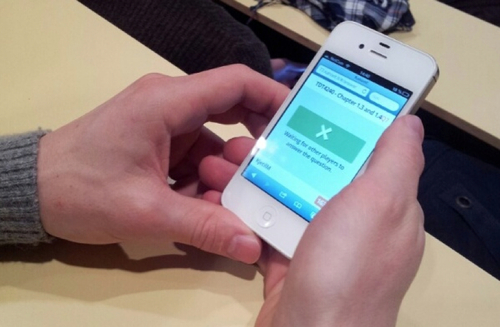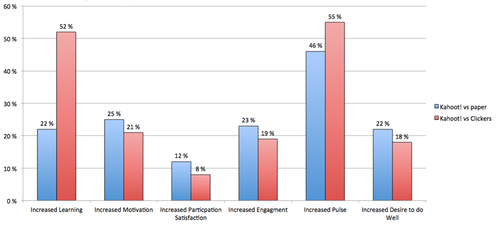The following post is from Kahoot! Inventor and Educator in Residence, Alf Inge Wang (@drfinge), Professor in Game Technology at the Norwegian University of Technology and Science.
There are many benefits of introducing quizzes to a lecture, like assessing the students knowledge, students get to think about what they have learned, students can get feedback on their understanding, and the benefits from breaking up lengthy teacher lecturing. But does it really matter how the quiz is carried out in the classroom?
A research project was launched fall 2013 at the Norwegian University of Science and Technology (NTNU) to investigate the effect of using three different quiz approaches in lectures:
- Running a quiz on paper
- Using the simple student-response system Clickers
- Using the game-based learning environment Kahoot!
The experiment was performed in the course TDT4110 IT Introduction course, which is taught to approx. 2000 students every year. Since the course is so large, the students are split up in five parallels of 500 students, who get the same lectures. Three parallels where picked out, where the same teacher taught the exact same lecture but used three different ways of running a quiz during the lecture. In addition to the topic lecturing, all the students in the experiment did a paper-based pre-test on the lecture’s topic before the lecture, and did the same test at the end of the lecture. The pre/post-test made it possible to see how much the students had learned during the lecture. In addition, the students filled out a questionnaire at the end of the lecture with questions about their engagement, motivation, and how they experienced the quiz.

The results showed that the students that did the game-based quiz (Kahoot!), learned 22% more than students that did paper quizzes, and 52% more than students that used the student-response system Clickers. Note however, that the results from the Clickers student-response system is unreliable as there was major technical issues running the system that also resulted in insufficient time to do the whole quiz. These results also show that using a student-response system does not automatically improve learning over paper solutions. It is very important that the technical infrastructure is robust and used in a correct way.

Further, the results showed that the students that used Kahoot! were 25% more motivated by the quiz compared to the paper quiz, and 21% more motivated than students using the non-game student-response system. Further, students playing the quiz on Kahoot! were respectively 12% and 8% more satisfied by completing the quiz compared to the paper and the student-response system quiz. The reported engagement in the lecture was respectively 23% and 19% higher for students playing Kahoot! compared to students doing the paper quiz and students doing the student-response system quiz. The engagement during the quiz in relation to feeling increased pulse was by the students that played Kahoot! reported to be 46% higher than students doing the paper quiz, and 55% higher than the students that used the student-response system. Finally, the urge to do well on the quiz was by the students that played Kahoot! 22% higher than students doing the quiz on paper, and 18% higher than the students using the student-response system.

To summarize the results, we can say that using a game-based learning tool like Kahoot! has a significant effect on how much the students learn, how they engage and their motivation in lectures. The results also suggest that a game-based quiz game will boost these effects compared to a non-game student response system. We can collaborate these results by the observation of how many students participate in lecture quizzes. From experiences using Kahoot! and the Clickers system throughout a semester, we found that when Kahoot! was used – on average more than 90% of the students participated in the quiz. When the Clickers system was used (without any technical issues), an average of 50-60% of the students participated. In surveys when we have asked the students about how these systems work for lecturing, it is obvious that the competition aspect of Kahoot! really draws the students into the quiz. The fact that they get points based on the way the answer and that if they do well their name can end up on the public scoreboard has a significant effect. Also students report that the fact that Kahoot! has music and audio effects, makes it very hard to ignore what is going on in the front of the classroom. As a student, you have to participate!




